The Evolution of the Glacier Surges in the Tuanjie Peak, the Qilian Mountains
Abstract
1. Introduction
2. Study Site
3. Data and Methodology
3.1. Glacier Delineation and Glacier Centerline Extraction
3.2. Velocity Mapping
3.3. Glacier Surface Elevation Changes
3.4. Identification of STGs
4. Results
4.1. STGs Overview
4.2. Glacier Surface Elevation and Ice Volume Changes
4.3. Ice Surface Velocities
4.4. Glacier Surface Morphology Changes
5. Discussion
5.1. Surge Characteristics
5.2. Motion Patterns of STGs
5.3. Surge Trigger Mechanisms
6. Conclusions
Supplementary Materials
Author Contributions
Funding
Institutional Review Board Statement
Informed Consent Statement
Data Availability Statement
Conflicts of Interest
References
- Hugonnet, R.; McNabb, R.; Berthier, E.; Menounos, B.; Nuth, C.; Girod, L.; Farinotti, D.; Huss, M.; Dussaillant, I.; Brun, F.; et al. Accelerated global glacier mass loss in the early twenty-first century. Nature 2021, 592, 726–731. [Google Scholar] [CrossRef] [PubMed]
- Farinotti, D.; Huss, M.; Fürst, J.J.; Landmann, J.; Machguth, H.; Maussion, F.; Pandit, A. A consensus estimate for the ice thickness distribution of all glaciers on Earth. Nat. Geosci. 2019, 12, 168–173. [Google Scholar] [CrossRef]
- Vale, A.B.; Arnold, N.S.; Rees, W.G.; Lea, J.M. Remote Detection of Surge-Related Glacier Terminus Change across High Mountain Asia. Remote Sens. 2021, 13, 1309. [Google Scholar] [CrossRef]
- Meier, M.F.; Post, A. What are glacier surges? Can. J. Earth Sci. 1969, 6, 807–817. [Google Scholar] [CrossRef]
- Murray, T.; Stuart, G.W.; Miller, P.J.; Woodward, J.; Smith, A.M.; Porter, P.R.; Jiskoot, H. Glacier surge propagation by thermal evolution at the bed. J. Geophys. Res. Solid Earth 2000, 105, 13491–13507. [Google Scholar] [CrossRef]
- Clarke, G.K.; Collins, S.G.; Thompson, D.E. Flow, thermal structure, and subglacial conditions of a surge-type glacier. Can. J. Earth Sci. 1984, 21, 232–240. [Google Scholar] [CrossRef]
- Gao, Y.; Liu, S.; Qi, M.; Xie, F.; Wu, K.; Zhu, Y. Glacier-related hazards along the international Karakoram Highway: Status and future perspectives. Front. Earth Sci. 2021, 9, 611501. [Google Scholar] [CrossRef]
- Bhambri, R.; Hewitt, K.; Kawishwar, P.; Pratap, B. Surge-type and surge-modified glaciers in the Karakoram. Sci. Rep. 2017, 7, 15391. [Google Scholar] [CrossRef] [PubMed]
- Goerlich, F.; Bolch, T.; Paul, F. More dynamic than expected: An updated survey of surging glaciers in the Pamir. Earth Syst. Sci. Data 2020, 12, 3161–3176. [Google Scholar] [CrossRef]
- Yasuda, T.; Furuya, M. Dynamics of surge-type glaciers in West Kunlun Shan, northwestern Tibet. J. Geophys. Res. Earth Surf. 2015, 120, 2393–2405. [Google Scholar] [CrossRef]
- Lovell, A.M.; Carr, J.R.; Stokes, C.R. Topographic controls on the surging behaviour of Sabche Glacier, Nepal (1967 to 2017). Remote Sens. Environ. 2018, 210, 434–443. [Google Scholar] [CrossRef]
- Zhou, S.; Yao, X.; Zhang, D.; Zhang, Y.; Liu, S.; Min, Y. Remote Sensing Monitoring of Advancing and Surging Glaciers in the Tien Shan, 1990–2019. Remote Sens. 2021, 13, 1973. [Google Scholar] [CrossRef]
- Lv, M.; Guo, H.; Yan, J.; Wu, K.; Liu, G.; Lu, X.; Ruan, Z.; Yan, S. Distinguishing Glaciers between Surging and Advancing by Remote Sensing: A Case Study in the Eastern Karakoram. Remote Sens. 2020, 12, 2297. [Google Scholar] [CrossRef]
- Baig, S.U.; Khan, H.; Muneeb, F.; Dad, K. Formation of a hazardous ice-dammed glacier lake: A case study of anomalous behavior of Hassanabad glacier system in the Karakoram. SN Appl. Sci. 2020, 2, 1285. [Google Scholar] [CrossRef]
- Sevestre, H.; Benn, D.I. Climatic and geometric controls on the global distribution of surge-type glaciers: Implications for a unifying model of surging. J. Glaciol. 2015, 61, 646–662. [Google Scholar] [CrossRef]
- Kamb, B. Glacier surge mechanism based on linked cavity configuration of the basal water conduit system. J. Geophys. Res. Solid Earth 1987, 92, 9083–9100. [Google Scholar] [CrossRef]
- Eisen, O.; Harrison, W.D.; Raymond, C.F.; Echelmeyer, K.A.; Bender, G.A.; Gorda, J.L. Variegated Glacier, Alaska, USA: A century of surges. J. Glaciol. 2005, 51, 399–406. [Google Scholar] [CrossRef]
- Fowler, A.C.; Murray, T.; Ng, F.S.L. Thermally controlled glacier surging. J. Glaciol. 2001, 47, 527–538. [Google Scholar] [CrossRef]
- Clarke, G.K. Thermal regulation of glacier surging. J. Glaciol. 1976, 16, 231–250. [Google Scholar] [CrossRef]
- Jiskoot, H.; Juhlin, D.T. Surge of a small East Greenland glacier, 2001–2007, suggests Svalbard-type surge mechanism. J. Glaciol. 2009, 55, 567–570. [Google Scholar] [CrossRef]
- Solgaard, A.M.; Simonsen, S.B.; Grinsted, A.; Mottram, R.; Karlsson, N.B.; Hansen, K.; Kusk, A.; Sørensen, L.S. Hagen Bræ: A surging glacier in North Greenland—35 years of observations. Geophys. Res. Lett. 2020, 47, e2019GL085802. [Google Scholar] [CrossRef] [PubMed]
- Benn, D.I.; Jones, R.L.; Luckman, A.; Fürst, J.J.; Hewitt, I.; Sommer, C. Mass and enthalpy budget evolution during the surge of a polythermal glacier: A test of theory. J. Glaciol. 2019, 65, 717–731. [Google Scholar] [CrossRef]
- Mukherjee, K.; Bolch, T.; Goerlich, F.; Kutuzov, S.; Osmonov, A.; Pieczonka, T.; Shesterova, I. Surge-type glaciers in the Tien shan (central asia). Arct. Antarct. Alp. Res. 2017, 49, 147–171. [Google Scholar] [CrossRef]
- Wendt, A.; Mayer, C.; Lambrecht, A.; Floricioiu, D. A Glacier Surge of Bivachny Glacier, Pamir Mountains, Observed by a Time Series of High-Resolution Digital Elevation Models and Glacier Velocities. Remote Sens. 2017, 9, 388. [Google Scholar] [CrossRef]
- Lv, M.; Guo, H.; Lu, X.; Liu, G.; Yan, S.; Ruan, Z.; Ding, Y.; Quincey, D.J. Characterizing the behaviour of surge-and non-surge-type glaciers in the Kingata Mountains, eastern Pamir, from 1999 to 2016. Cryosphere 2019, 13, 219–236. [Google Scholar] [CrossRef]
- Wu, K.; Liu, S.; Jiang, Z.; Zhu, Y.; Xie, F.; Gao, Y.; Yi, Y.; Tahir, A.A.; Muhammad, S. Surging Dynamics of Glaciers in the Hunza Valley under an Equilibrium Mass State since 1990. Remote Sens. 2020, 12, 2922. [Google Scholar] [CrossRef]
- Steiner, J.F.; Kraaijenbrink, P.D.; Jiduc, S.G.; Immerzeel, W.W. Brief communication: The Khurdopin glacier surge revisited–extreme flow velocities and formation of a dammed lake in 2017. Cryosphere 2018, 12, 95–101. [Google Scholar] [CrossRef]
- Round, V.; Leinss, S.; Huss, M.; Haemmig, C.; Hajnsek, I. Surge dynamics and lake outbursts of Kyagar Glacier, Karakoram. Cryosphere 2017, 11, 723–739. [Google Scholar] [CrossRef]
- Quincey, D.J.; Glasser, N.F.; Cook, S.J.; Luckman, A. Heterogeneity in Karakoram glacier surges. J. Geophys. Res. Earth Surf. 2015, 120, 1288–1300. [Google Scholar] [CrossRef]
- Chudley, T.R.; Willis, I.C. Glacier surges in the north-west West Kunlun Shan inferred from 1972 to 2017 Landsat imagery. J. Glaciol. 2019, 65, 1–12. [Google Scholar] [CrossRef]
- King, O.; Bhattacharya, A.; Bolch, T. The presence and influence of glacier surging around the Geladandong ice caps, North East Tibetan Plateau. Adv. Clim. Chang. Res. 2021, 12, 299–312. [Google Scholar] [CrossRef]
- Yan, J.; Lv, M.; Ruan, Z.; Yan, S.; Liu, G. Evolution of Surge-Type Glaciers in the Yangtze River Headwater Using Multi-Source Remote Sensing Data. Remote Sens. 2019, 11, 2991. [Google Scholar] [CrossRef]
- Zhang, Z.; Du, Z.; Liu, S.; Jiang, Z.; Shangguan, D.; Wei, J.; Xu, J.; Zhang, S. Glacier mass changes over Duxueshan, Burog Kangri, and Zangser Kangri in the Inner Tibetan Plateau. Environ. Earth Sci. 2020, 79, 292. [Google Scholar] [CrossRef]
- Jia, B.; Hou, S.; Wang, Y. A Surging Glacier Recognized by Remote Sensing on the Zangser Kangri Ice Field, Central Tibetan Plateau. Remote Sens. 2021, 13, 1220. [Google Scholar] [CrossRef]
- Xu, J.; Liu, S.; Zhang, S.; Guo, W.; Wang, J. Recent changes in glacial area and volume on Tuanjiefeng Peak Region of Qilian Mountains, China. PLoS ONE 2013, 8, e70574. [Google Scholar] [CrossRef] [PubMed]
- Sun, M.; Liu, S.; Yao, X.; Guo, W.; Xu, J. Glacier changes in the Qilian Mountains in the past half-century: Based on the revised First and Second Chinese Glacier Inventory. J. Geogr. Sci. 2018, 28, 206–220. [Google Scholar] [CrossRef]
- Du, W.; Kang, S.; Qin, X.; Ji, Z.; Sun, W.; Chen, J.; Yang, J.; Chen, D. Can summer monsoon moisture invade the Jade Pass in Northwestern China? Clim. Dyn. 2020, 55, 3101–3115. [Google Scholar] [CrossRef]
- Liu, S.Y.; Yao, X.J.; Guo, W.Q.; Xu, J.; Shangguan, D.; Wei, J.; Bao, W.J.; Wu, L. The contemporary glaciers in China based on the Second Chinese Glacier Inventory. Acta Geogr. Sin. 2015, 70, 3–16. [Google Scholar] [CrossRef]
- Nolan, A.; Kochtitzky, W.; Enderlin, E.M.; McNabb, R.; Kreutz, K.J. Kinematics of the exceptionally-short surge cycles of Sít’Kusá (Turner Glacier), Alaska, from 1983 to 2013. J. Glaciol. 2021, 67, 744–758. [Google Scholar] [CrossRef]
- Xie, F.; Liu, S.; Wu, K.; Zhu, Y.; Gao, Y.; Qi, M.; Duan, S.; Saifullah, M.; Tahir, A.A. Upward Expansion of Supra-Glacial Debris Cover in the Hunza Valley, Karakoram, During 1990∼2019. Front. Earth Sci. 2020, 8, 308. [Google Scholar] [CrossRef]
- Guo, W.; Liu, S.; Xu, L.; Wu, L.; Shangguan, D.; Yao, X.; Wei, J.; Bao, W.; Yu, P.; Liu, Q.; et al. The second Chinese glacier inventory: Data, methods and results. J. Glaciol. 2015, 61, 357–372. [Google Scholar] [CrossRef]
- Liu, J.; Yao, X.; Liu, S.; Guo, W.; Xu, J. Glacial changes in the Gangdisê Mountains from 1970 to 2016. J. Geogr. Sci. 2020, 30, 131–144. [Google Scholar] [CrossRef]
- Zhang, D.; Yao, X.; Duan, H.; Liu, S.; Guo, W.; Sun, M.; Li, D. A new automatic approach for extracting glacier centerlines based on Euclidean allocation. Cryosphere 2021, 15, 1955–1973. [Google Scholar] [CrossRef]
- Wu, K.; Liu, S.; Jiang, Z.; Xu, J.; Wei, J.; Guo, W. Recent glacier mass balance and area changes in the Kangri Karpo Mountains from DEMs and glacier inventories. Cryosphere 2018, 12, 103–121. [Google Scholar] [CrossRef]
- Leprince, S.; Ayoub, F.; Klinger, Y.; Avouac, J.P. Co-registration of optically sensed images and correlation (COSI-Corr): An operational methodology for ground deformation measurements. In Proceedings of the 2007 IEEE International Geoscience and Remote Sensing Symposium, Barcelona, Spain, 23–28 July 2007; pp. 1943–1946. [Google Scholar] [CrossRef]
- Zhang, Z.; Liu, S.; Jiang, Z.; Shangguan, D.; Wei, J.; Guo, W.; Xu, J.; Zhang, Y.; Zhang, S.; Huang, D. Glacier Variations at Xinqingfeng and Malan Ice Caps in the Inner Tibetan Plateau Since 1970. Remote Sens. 2020, 12, 421. [Google Scholar] [CrossRef]
- Wang, L.; Jiang, Z.; Liu, S.; Shangguan, D.; Zhang, Y. Characteristic of Glaciers’ Movement Along Karakoram Highway. Remote Sens. Technol. Appl. 2019, 34, 412–423. [Google Scholar] [CrossRef]
- Zhang, S.; Zhang, Z.; Liu, S.; Li, X.; Huang, D.; Xue, N. Terrain dependence characteristics of glacier flow velocity in northwest of the Karakoram Mountains. J. Glaciol. Geocryol. 2019, 41, 1015–1025. [Google Scholar] [CrossRef]
- Girod, L.; Nuth, C.; Kääb, A.; McNabb, R.; Galland, O. MMASTER: Improved ASTER DEMs for Elevation Change Monitoring. Remote Sens. 2017, 9, 704. [Google Scholar] [CrossRef]
- Farr, T.; Rosen, P.A.; Caro, E.; Crippen, R.E.; Duren, R.M.; Hensley, S.; Kobrick, M.; Paller, M.; Rodriguez, E.; Roth, L.; et al. The shuttle radar topography mission. Rev. Geophys. 2007, 45, RG2004. [Google Scholar] [CrossRef]
- Rodriguez, E.; Morris, C.S.; Belz, J.E. A global assessment of the SRTM performance. Photogramm. Eng. Remote Sens. 2006, 72, 249–260. [Google Scholar] [CrossRef]
- Wu, K.; Liu, S.; Jiang, Z.; Xu, J.; Wei, J. Glacier mass balance over the central Nyainqentanglha Range during recent decades derived from remote-sensing data. J. Glaciol. 2019, 65, 422–439. [Google Scholar] [CrossRef]
- Berthier, E.; Schiefer, E.; Clarke, G.K.; Menounos, B.; Rémy, F. Contribution of Alaskan glaciers to sea-level rise derived from satellite imagery. Nat. Geosci. 2010, 3, 92–95. [Google Scholar] [CrossRef]
- Nuth, C.; Kääb, A. Co-registration and bias corrections of satellite elevation data sets for quantifying glacier thickness change. Cryosphere 2011, 5, 271–290. [Google Scholar] [CrossRef]
- Ke, L.; Song, C.; Yong, B.; Lei, Y.; Ding, X. Which heterogeneous glacier melting patterns can be robustly observed from space? A multi-scale assessment in southeastern Tibetan Plateau. Remote Sens. Environ. 2020, 242, 111777. [Google Scholar] [CrossRef]
- Zhou, Y.; Li, Z.; Li, J.; Zhao, R.; Ding, X. Glacier mass balance in the QTP and its surroundings from the mid-1970s to 2000 based on Hexagon KH-9 and SRTM DEMs. Remote Sens. Environ. 2018, 210, 96–112. [Google Scholar] [CrossRef]
- Bolch, T.; Pieczonka, T.; Benn, D.I. Multi-decadal mass loss of glaciers in the Everest area (Nepal Himalaya) derived from stereo imagery. Cryosphere 2011, 5, 349–358. [Google Scholar] [CrossRef]
- Li, C.; Jiang, L.; Liu, L.; Wang, H. Regional and altitude-dependent estimate of the SRTM C/X-band radar penetration difference on High Mountain Asia glaciers. IEEE J. Sel. Top. Appl. Earth Obs. Remote Sens. 2021, 14, 4244–4253. [Google Scholar] [CrossRef]
- Kääb, A.; Jacquemart, M.; Gilbert, A.; Leinss, S.; Girod, L.; Huggel, C.; Falaschi, D.; Ugalde, F.; Petrakov, D.; Chernomorets, S.; et al. Sudden large-volume detachments of low-angle mountain glaciers–more frequent than thought? Cryosphere 2021, 15, 1751–1785. [Google Scholar] [CrossRef]
- RGI Consortium. Randolph Glacier Inventory–A Dataset of Global Glacier Outlines: Version 6.0: Technical Report, Global Land Ice Measurements from Space; Digital Media: Denver, CO, USA, 2017. [Google Scholar] [CrossRef]
- Kamb, B.; Raymond, C.F.; Harrison, W.D.; Engelhardt, H.; Echelmeyer, K.A.; Humphrey, N.F.; Brugman, M.M.; Pfeffer, T. Glacier surge mechanism: 1982-1983 surge of Variegated Glacier, Alaska. Science 1985, 227, 469–479. [Google Scholar] [CrossRef]
- Guo, L.; Li, J.; Wu, L.; Li, Z.; Liu, Y.; Li, X.; Miao, Z.; Wang, W. Investigating the Recent Surge in the Monomah Glacier, Central Kunlun Mountain Range with Multiple Sources of Remote Sensing Data. Remote Sens. 2020, 12, 966. [Google Scholar] [CrossRef]
- Raymond, C.F. How do glaciers surge? A review. J. Geophys. Res. Solid Earth 1987, 92, 9121–9134. [Google Scholar] [CrossRef]
- Van Geffen, S.; Oerlemans, J. The 1982/83 surge and antecedent quiescent phase of Variegated Glacier: Revising the original dataset for application in flow line models. J. Glaciol. 2017, 63, 772–782. [Google Scholar] [CrossRef][Green Version]
- Frappé, T.P.; Clarke, G.K. Slow surge of Trapridge Glacier, Yukon Territory, Canada. J. Geophys. Res. Earth Surf. 2007, 112, F03S32. [Google Scholar] [CrossRef]
- Gilbert, A.; Leinss, S.; Kargel, J.; Kääb, A.; Gascoin, S.; Leonard, G.; Berthier, E.; Karki, A.; Yao, T. Mechanisms leading to the 2016 giant twin glacier collapses, Aru Range, Tibet. Cryosphere 2018, 12, 2883–2900. [Google Scholar] [CrossRef]
- Lingle, C.S.; Fatland, D.R. Does englacial water storage drive temperate glacier surges? Ann. Glaciol. 2003, 36, 14–20. [Google Scholar] [CrossRef]
- Bartholomaus, T.C.; Anderson, R.S.; Anderson, S.P. Growth and collapse of the distributed subglacial hydrologic system of Kennicott Glacier, Alaska, USA, and its effects on basal motion. J. Glaciol. 2011, 57, 985–1002. [Google Scholar] [CrossRef]
- Bueler, E. Extending the lumped subglacial–englacial hydrology model of Bartholomaus and others (2011). J. Glaciol. 2014, 60, 808–810. [Google Scholar] [CrossRef]
- Wang, H.; Jia, B.; Wang, Y.; Hou, S. Glacier changes in Shulenan Mountain from 1973 to 2018. J. Arid Land Resour. Environ. 2021, 35, 60–65. [Google Scholar] [CrossRef]
- Sun, J.; Yang, K.; Guo, W.; Wang, Y.; He, J.; Lu, H. Why has the Inner Tibetan Plateau become wetter since the mid-1990s? J. Clim. 2020, 33, 8507–8522. [Google Scholar] [CrossRef]
- Zhang, H.; Li, Z.; Zhou, P. Mass balance reconstruction for Shiyi Glacier in the Qilian Mountains, Northeastern Tibetan Plateau, and its climatic drivers. Clim. Dyn. 2021, 56, 969–984. [Google Scholar] [CrossRef]
- Clarke, G.K.; Hambrey, M.J. Structural evolution during cyclic glacier surges: 2. Numerical modeling. J. Geophys. Res. Earth Surf. 2019, 124, 495–525. [Google Scholar] [CrossRef]
- Yan, Y.; You, Q.; Wu, F.; Pepin, N.; Kang, S. Surface mean temperature from the observational stations and multiple reanalyses over the Tibetan Plateau. Clim. Dyn. 2020, 55, 2405–2419. [Google Scholar] [CrossRef]
- Wang, Y.; Zhang, T.; Ren, J.; Qin, X.; Liu, Y.; Sun, W.; Chen, J.; Ding, M.; Du, W.; Qin, D. An investigation of the thermomechanical features of Laohugou Glacier No. 12 on Qilian Shan, western China, using a two-dimensional first-order flow-band ice flow model. Cryosphere 2018, 12, 851–866. [Google Scholar] [CrossRef]
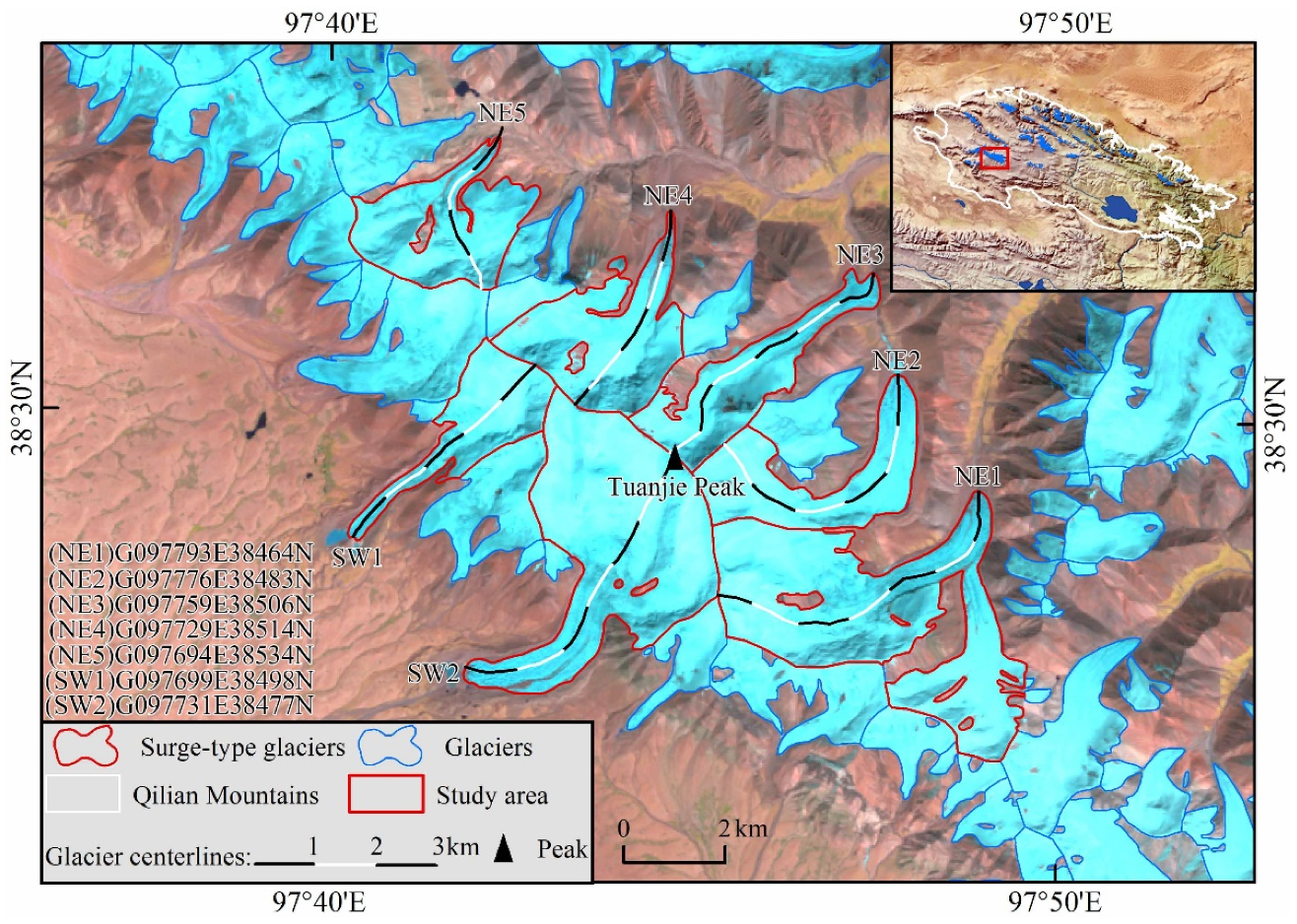
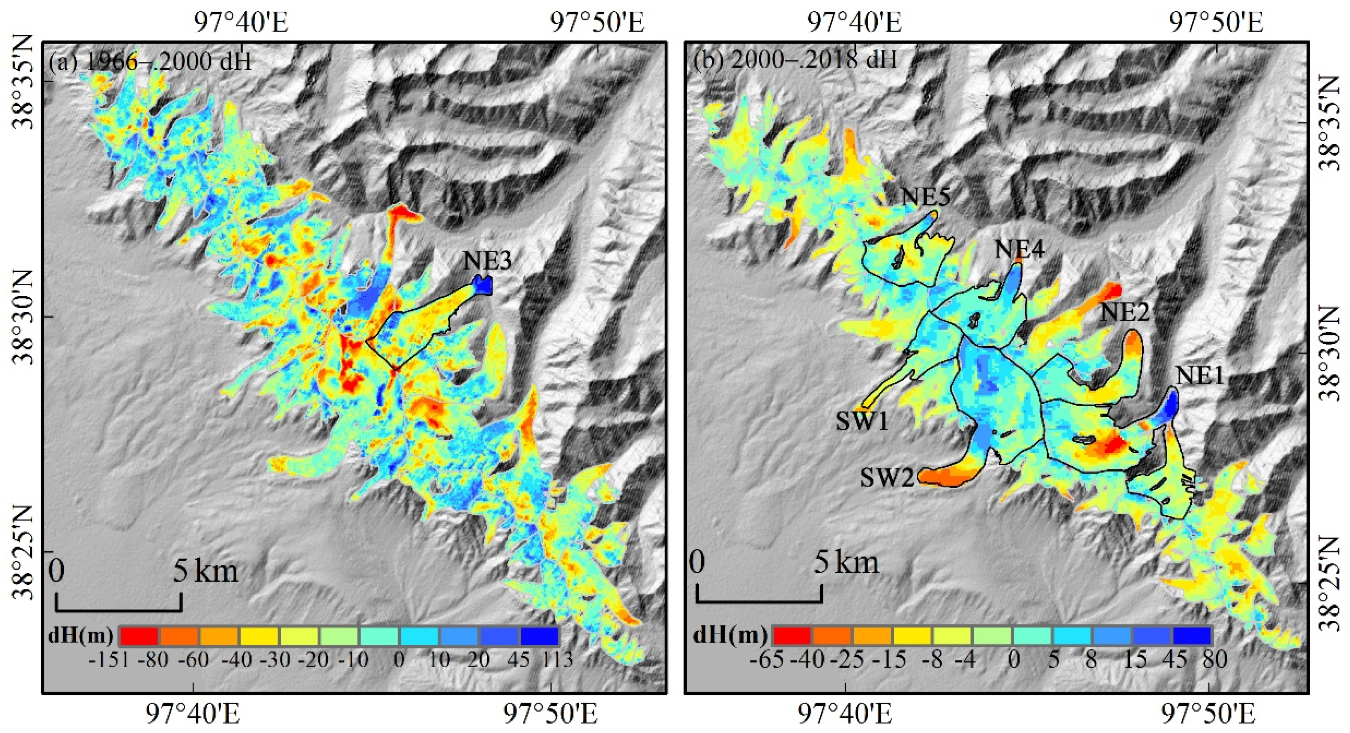
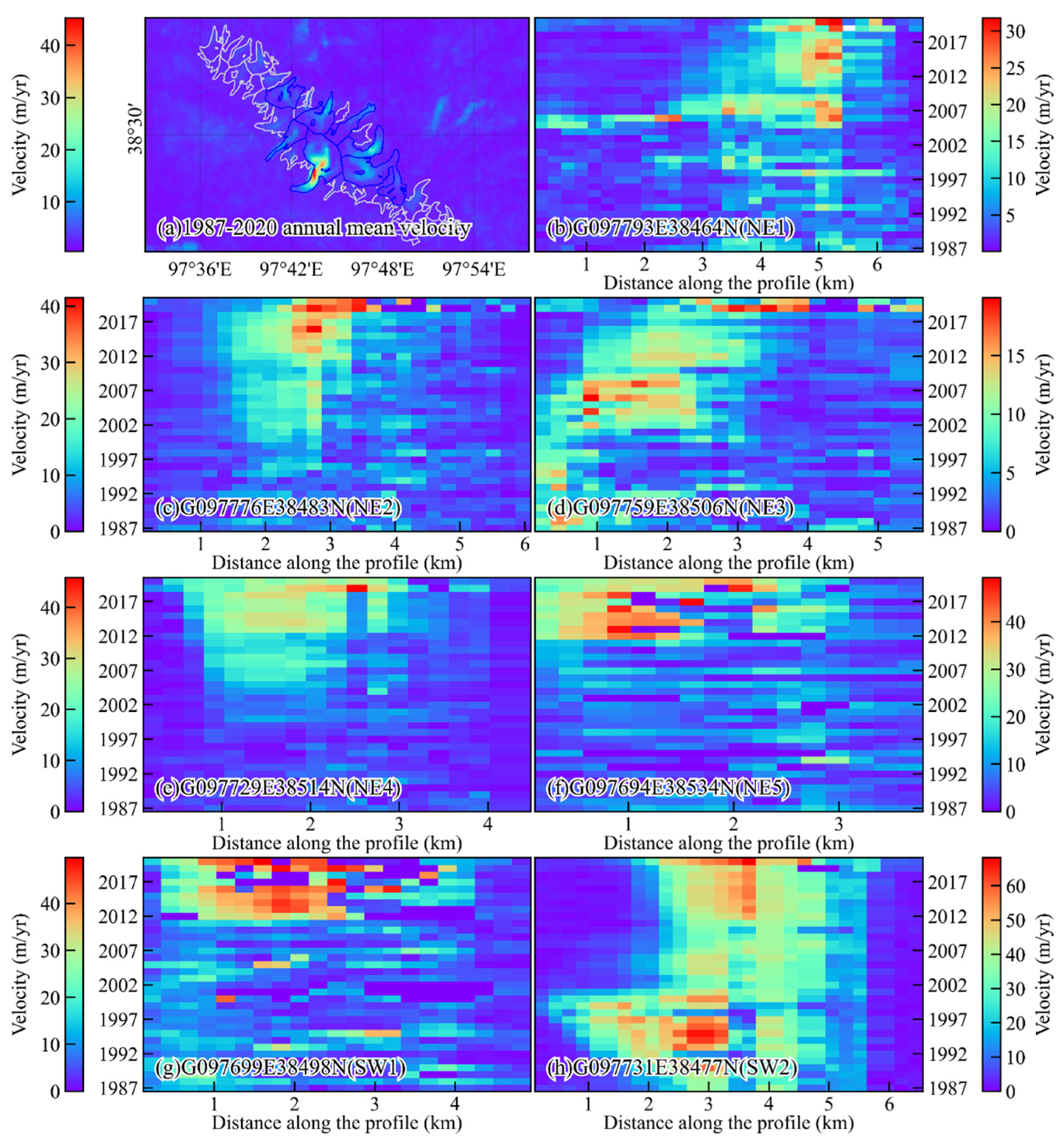
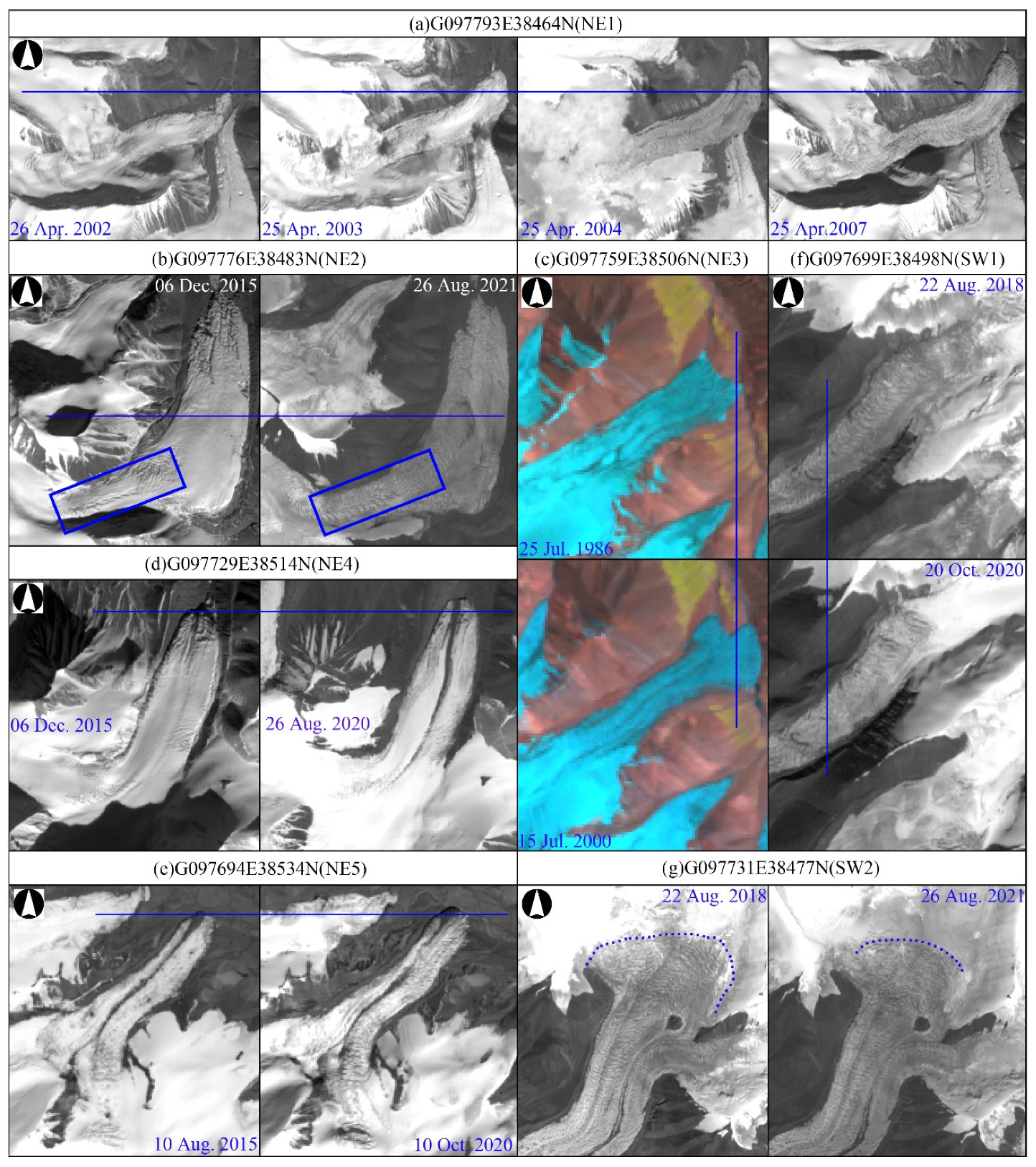
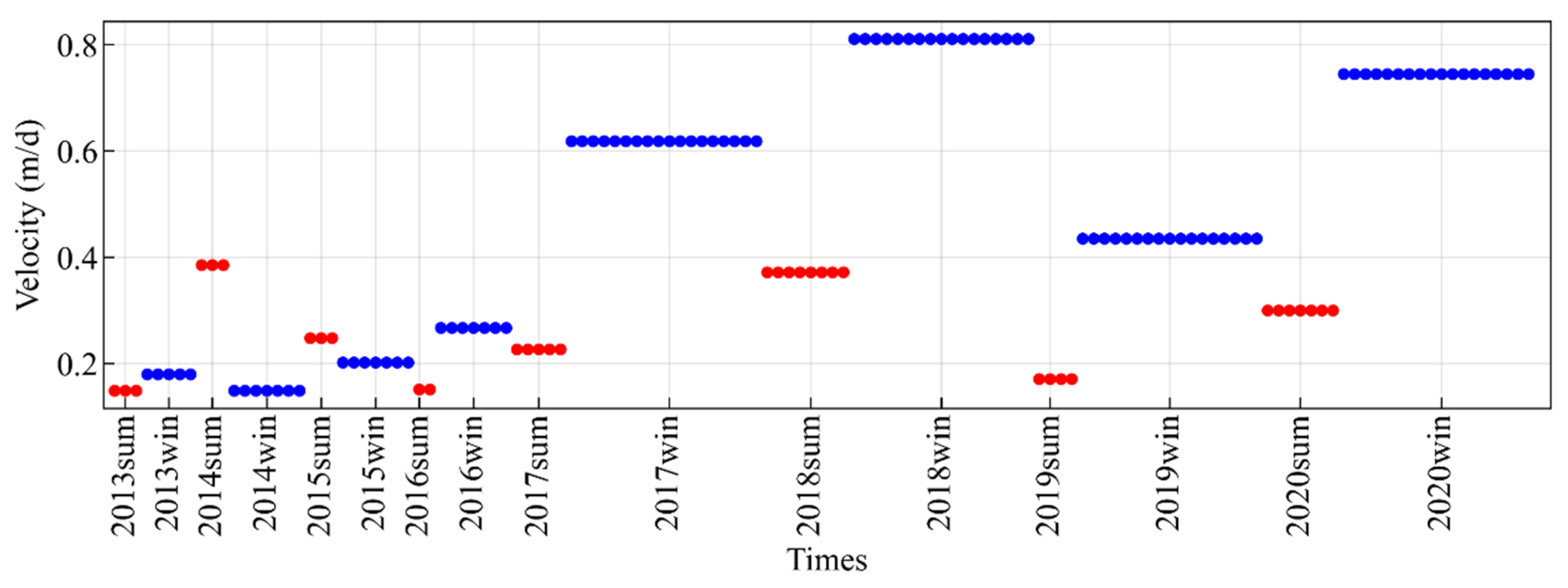
| Date | Sources | Path/Row | Pixel Size (m) | Amount | Application |
|---|---|---|---|---|---|
| 1973–1977 | Landsat MSS | 145/033 | 60 × 60 | 4 | Identification of glacier outlines |
| 1986–2011 | Landsat TM | 135/033 | 30 × 30 | 138 | Identification of glacier outlines Visualization of glacier surface morphology Extraction glacier surface flow velocity |
| 1999–2003 | Landsat ETM+ | 135/033 | 15 × 15 | 17 | Identification of glacier outlines |
| 2013–2020 | Landsat OLI | 135/033 | 15 × 15 | 35 | Identification of glacier outlines Extraction glacier surface flow velocity |
| 2000–2020 | ASTER | - | 15 × 15 | 30 | Identification of glacier outlines Visualization of glacier surface morphology Extraction glacier surface flow velocity |
| 2015–2020 | Sentinel-2 | - | 10 × 10 | 108 | Accuracy assessment of glacier length Visualization of glacier surface morphology Extraction glacier surface flow velocity |
| 2000 | SRTM-C | 30 | 1 | Extraction of glacier centerlines |
| Item | MED (m) | STDV (m) | N | SE (m) | δ (m) |
|---|---|---|---|---|---|
| SRTM-TOPO DEM | −1.06 | 8.35 | 7756 | 0.09 | 1.07 |
| ASD02-SRTM | −2.87 | 6.05 | 12700 | 0.05 | 2.87 |
| ASD07-ASD02 | −0.64 | 6.46 | 12700 | 0.06 | 0.64 |
| ASD12-ASD07 | 2.66 | 5.42 | 12700 | 0.05 | 2.66 |
| ASD18-ASD12 | 2.57 | 6.22 | 12700 | 0.06 | 2.26 |
| No. | GLIMS_ID | Area (km2) | Lengthmax (km) | Max/Min/Med Elevation (m) | Mean Slope (°) | Aspect | Debris Cover (%) |
|---|---|---|---|---|---|---|---|
| NE1 | G097793E38464N | 14.95 | 7.34 | 5582/4411/5016 | 17.8 | NE | 1.73 |
| NE2 | G097776E38483N | 5.89 | 6.51 | 5727/4516/5063 | 14.5 | NE | 2.39 |
| NE3 | G097759E38506N | 5.14 | 6.02 | 5716/4371/4986 | 21.3 | NE | 5.78 |
| NE4 | G097729E38514N | 6.94 | 5.48 | 5750/4557/5064 | 22.4 | NE | 1.23 |
| NE5 | G097694E38534N | 6.10 | 4.05 | 5522/4602/5011 | 20.1 | NE | 0.56 |
| SW1 | G097699E38498N | 4.45 | 5.50 | 5760/4623/5278 | 20.7 | SW | 0.84 |
| SW2 | G097731E38477N | 14.10 | 7.85 | 5755/4557/5297 | 17.2 | SW | 1.40 |
| No. | Evidence of Surge Events | Surge Initiating Year | Surge Terminating Year | Surge Duration (years) | Area Changed (km2) | Length Changed (m) |
|---|---|---|---|---|---|---|
| NE1 | Terminus advanced from 2002 to 2004; Velocities during the active phase typically reach at least an order of magnitude higher than during the passive, quiescent phase. | 2002 | 2006 | 5 | 0.64 ± 0.78 | 718.41 ± 18.35 |
| NE2 | Changes in ice crevasses; looped moraines; Clear thickened reservoir area and thinned receiving area. | 2000 | - | >20 | −0.32 ± 0.24 | −103.83 ± 10.62 |
| NE3 | Terminus advanced; Obvious thinned reservoir area and thickened receiving area during study period. | Before 1986 | 2000 | >15 | 0.48 ± 0.32 | 539.88 ± 12.35 |
| NE4 | Terminus advanced since 2015; Obvious thinned reservoir area and thickened receiving area. | 2013 | - | >8 | 0.05 ± 0.28 | 98.97 ± 22.35 |
| NE5 | Terminus advanced since 2012; Obvious thinned reservoir area and thickened receiving area. | 2012 | - | >9 | −0.03 ± 0.37 | 114.65 ± 14.21 |
| SW1 | Surface features show clear movement; Clear thickened reservoir area and thinned receiving area. | 2012 | - | >9 | −0.08 ± 0.23 | −78.14 ± 2.80 |
| SW2 | Changes in ice crevasses; Clear thickened reservoir area and thinned receiving area. | 2012 | - | >9 | −0.09 ± 0.49 | −304.13 ± 17.60 |
| No. | GLIMS_ID | Data | Mean ∆H of Reservoir Area (m) | Mean ∆H of Receiving Area (m) | Transfer of Ice Volume (×107 m3) |
|---|---|---|---|---|---|
| NE1 | G097793E38464N | 2002–2007 | −22.24 ± 0.64 | 53.10 ± 0.64 | 5.71 ± 0.69 |
| NE2 | G097776E38483N | 2012–2018 | −6.41 ± 2.26 | 1.93 ± 2.26 | 0.11 ± 0.13 |
| NE3 | G097759E38506N | 1966–2000 | −29.93 ± 1.07 | 45.07 ± 1.07 | 2.71 ± 0.06 |
| NE4 | G097729E38514N | 2012–2018 | −13.76 ± 2.26 | 10.76 ± 2.26 | 0.34 ± 0.07 |
| NE5 | G097694E38534N | 2012–2018 | −5.57 ± 2.26 | 5.96 ± 2.26 | 0.32 ± 0.12 |
| SW1 | G097699E38498N | 2012–2018 | 13.44 ± 2.26 | −4.38 ± 2.26 | - |
| SW2 | G097731E38477N | 2012–2018 | 7.45 ± 2.26 | −10.02 ± 2.26 | - |
| Region | Category | Sample | Area (km2) | Slope (°) | Lengthmax (km) | Max/Min/Med Elevation (m) | Surge Duration (yr) | Period (yr) | Velocitymax (m a−1) | Terminus Advance (km) |
|---|---|---|---|---|---|---|---|---|---|---|
| Tian Shan | Surge | 23 | 65.59 | 22.38 | 12.82 | 5540/3447/4392 | 2 to 10 | 35 to 60 | - | 0.12 to 3.2 |
| No-surge | 1934 | 1.59 | 28.58 | 1.47 | 4483/3888/4178 | |||||
| Pamirs | Surge | 186 | 16.84 | 22.52 | 7.87 | 5809/3876/4817 | <1 to ≤5 | 8 to 10 | 40 to 150 | 0.2 to 5.88 |
| No-surge | 9597 | 0.57 | 27.06 | 1.08 | 5100/4650/4868 | |||||
| Karakoram | Surge | 258 | 42.11 | 25.14 | 11.19 | 6425/4379/5384 | <1 to >15 | 8 to 34 | 300 to 5200 | 0.11 to 6.1 |
| No-surge | 13576 | 0.89 | 30.35 | 1.19 | 5665/5156/5417 | |||||
| West Kunlun Mountains | Surge | 20 | 89.41 | 11.36 | 18.07 | 6632/5170/6102 | >5 | >42 | 200 to 1200 | 0.03 to 1.65 |
| No-surge | 528 | 2.46 | 23.39 | 1.87 | 6206/5684/5976 | |||||
| Puruogangri | Surge | 3 | 22.54 | 11.67 | 7.59 | 6300/5390/5879 | - | - | - | - |
| No-surge | 56 | 5.89 | 18.37 | 3.11 | 6102/5574/5852 | |||||
| Xinqingfeng and Malan | Surge | 8 | 32.43 | 13.81 | 11.07 | 6485/5031/5685 | 1 to 7 | - | - | 0.04 to 1.2 |
| No-surge | 97 | 3.42 | 18.19 | 2.39 | 5812/5260/5557 | |||||
| Geladandong | Surge | 12 | 24.15 | 12 | 9.03 | 6391/5366/5780 | >3 to >19 | - | 30 to 90 | 0.17 to 1.8 |
| No-surge | 207 | 2.68 | 18.89 | 2.12 | 5971/5513/5754 | |||||
| Muztag | Surge | 5 | 55.31 | 11.04 | 12.94 | 6618/5199/5735 | 4 | >40 | - | 0.55 |
| No-surge | 209 | 1.84 | 22.03 | 1.49 | 5727/5342/5543 | |||||
| TJP | Surge | 7 | 8.22 | 19.14 | 6.11 | 5687/4519/5102 | 5 to >20 | - | 20 to 68 | 0.11 to 0.72 |
| No-surge | 71 | 1.09 | 24.02 | 1.57 | 5257/4751/5031 |
Publisher’s Note: MDPI stays neutral with regard to jurisdictional claims in published maps and institutional affiliations. |
© 2022 by the authors. Licensee MDPI, Basel, Switzerland. This article is an open access article distributed under the terms and conditions of the Creative Commons Attribution (CC BY) license (https://creativecommons.org/licenses/by/4.0/).
Share and Cite
Gao, Y.; Liu, S.; Qi, M.; Yao, X.; Zhu, Y.; Xie, F.; Wu, K.; Saifullah, M. The Evolution of the Glacier Surges in the Tuanjie Peak, the Qilian Mountains. Remote Sens. 2022, 14, 852. https://doi.org/10.3390/rs14040852
Gao Y, Liu S, Qi M, Yao X, Zhu Y, Xie F, Wu K, Saifullah M. The Evolution of the Glacier Surges in the Tuanjie Peak, the Qilian Mountains. Remote Sensing. 2022; 14(4):852. https://doi.org/10.3390/rs14040852
Chicago/Turabian StyleGao, Yongpeng, Shiyin Liu, Miaomiao Qi, Xiaojun Yao, Yu Zhu, Fuming Xie, Kunpeng Wu, and Muhammad Saifullah. 2022. "The Evolution of the Glacier Surges in the Tuanjie Peak, the Qilian Mountains" Remote Sensing 14, no. 4: 852. https://doi.org/10.3390/rs14040852
APA StyleGao, Y., Liu, S., Qi, M., Yao, X., Zhu, Y., Xie, F., Wu, K., & Saifullah, M. (2022). The Evolution of the Glacier Surges in the Tuanjie Peak, the Qilian Mountains. Remote Sensing, 14(4), 852. https://doi.org/10.3390/rs14040852







